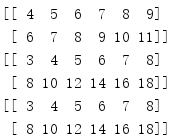1. numpy scientific computing base
1.1 what is numpy
NumPy(Numerical Python) is an extension library of Python language, which supports a large number of dimension arrays and matrix operations. In addition, it also provides a large number of mathematical function libraries for array operations.
NumPy's predecessor, Numeric, was first developed by Jim Hugunin and other collaborators. In 2005, Travis Oliphant combined the features of another program library Numarray of the same nature in Numeric and added other extensions to develop NumPy. NumPy is open source and is maintained and developed by many collaborators.
NumPy is a very fast math library, mainly used for array calculation, including:
- A powerful N-dimensional array object, ndarray
- Broadcast function
- Tools for integrating C/C++/Fortran code
- Linear algebra, Fourier transform, random number generation and other functions
1.2 create array (matrix)
# coding=utf-8 import numpy as np #Use numpy Generated array,obtain ndarray Types t1 = np.array([1,2,3,]) print(t1) print(type(t1)) t2 = np.array(range(10)) print(t2) print(type(t2)) t3 = np.arange(4,10,2) print(t3) print(type(t3)) print(t3.dtype)
Operation result
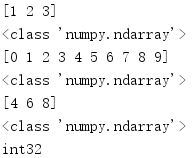
1.3 data type
| Name | describe |
|---|---|
| bool_ | Boolean data type (True or False) |
| int_ | Default integer type (similar to long, int32 or int64 in C) |
| intc | Like the int type of C, it is generally int32 or int 64 |
| intp | Integer type used for index (similar to ssize'ut of C, still int32 or int64 in general) |
| int8 | Bytes (- 128 to 127) |
| int16 | Integer (- 32768 to 32767) |
| int32 | Integer (- 2147483648 to 2147483647) |
| int64 | Integer (- 9223372036854775808 to 9223372036854775807) |
| uint8 | Unsigned integer (0 to 255) |
| uint16 | Unsigned integer (0 to 65535) |
| uint32 | Unsigned integer (0 to 4294967295) |
| uint64 | Unsigned integer (0 to 18446744073709551615) |
| float_ | Shorthand for float64 type |
| float16 | Semi precision floating-point number, including: 1 sign bit, 5 fingers, 10 tails |
| float32 | Single precision floating-point number, including: 1 sign bit, 8 fingers, 23 tails |
| float64 | Double precision floating-point number, including: 1 sign bit, 11 fingers, 52 tails |
| complex_ | Short for complex128 type, i.e. 128 bit complex |
| complex64 | Complex number, indicating double 32-bit floating-point number (real part and imaginary part) |
| complex128 | Complex number, indicating double 64 bit floating-point number (real part and imaginary part) |
# coding=utf-8 import numpy as np import random # int8, int16, int32, int64 Four data types can use strings 'i1', 'i2','i4','i8' replace t1 = np.array(range(1,4),dtype="i1") print(t1) print(t1.dtype) ##bool type in numpy t2 = np.array([1,1,0,1,0,0],dtype=bool) print(t2) print(t2.dtype) #Adjust data type t3 = t2.astype("int8") print(t3) print(t3.dtype) #numpy Decimal fraction t4 = np.array([random.random() for i in range(10)]) print(t4) print(t4.dtype) t5 = np.round(t4,2) print(t5)
Operation result:
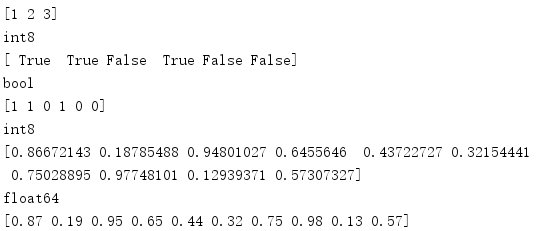
1.4 shape of array
# coding=utf-8 import numpy as np a = np.array([[3,4,5,6,7,8],[4,5,6,7,8,9]]) print(a) #View array shapes print(a.shape) #Modify array shape print(a.reshape(3,4)) #Original array shape unchanged print(a.shape) b = a.reshape(3,4) print(b.shape) print(b) #Convert array to 1 dimension data print(b.reshape(1,12)) print(b.flatten())
Operation result:
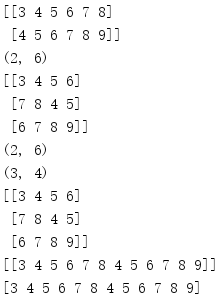
1.5 calculation of array and number
# coding=utf-8 import numpy as np a = np.array([[3,4,5,6,7,8],[4,5,6,7,8,9]]) print(a) #addition and subtraction print(a+5) print(a-5) #Multiplication division print(a*3) print(a/3)
Operation result:
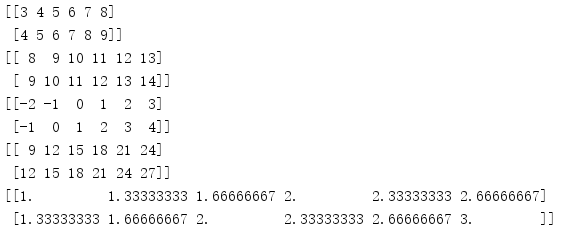
1.6 array and array calculation
# coding=utf-8 import numpy as np a = np.array([[3,4,5,6,7,8],[4,5,6,7,8,9]]) b = np.array([[21,22,23,24,25,26],[27,28,29,30,31,32]]) #Addition and subtraction of arrays and arrays print(a+b) print(a-b) #Multiplication and division of arrays and arrays print(a*b) print(a/b)
Operation result:

Calculation of different dimension arrays:
# coding=utf-8 import numpy as np a = np.array([[3,4,5,6,7,8],[4,5,6,7,8,9]]) c = np.array([[1,2,3,4],[5,6,7,8],[9,10,11,12]]) #Array calculation of different dimensions print(a*c)
Operation result:

# coding=utf-8 import numpy as np #2 Array of Row 6 columns a = np.array([[3,4,5,6,7,8],[4,5,6,7,8,9]]) #1 Array of Row 6 columns c = np.array([1,2,3,4,5,6]) print(a-c) print(a*c)
Operation result:

# coding=utf-8 import numpy as np #2 Array of Row 6 columns a = np.array([[3,4,5,6,7,8],[4,5,6,7,8,9]]) #1 Array of Row 6 columns c = np.array([[1],[2]]) print(a+c) print(a*c) print(c*a)
Operation result:
